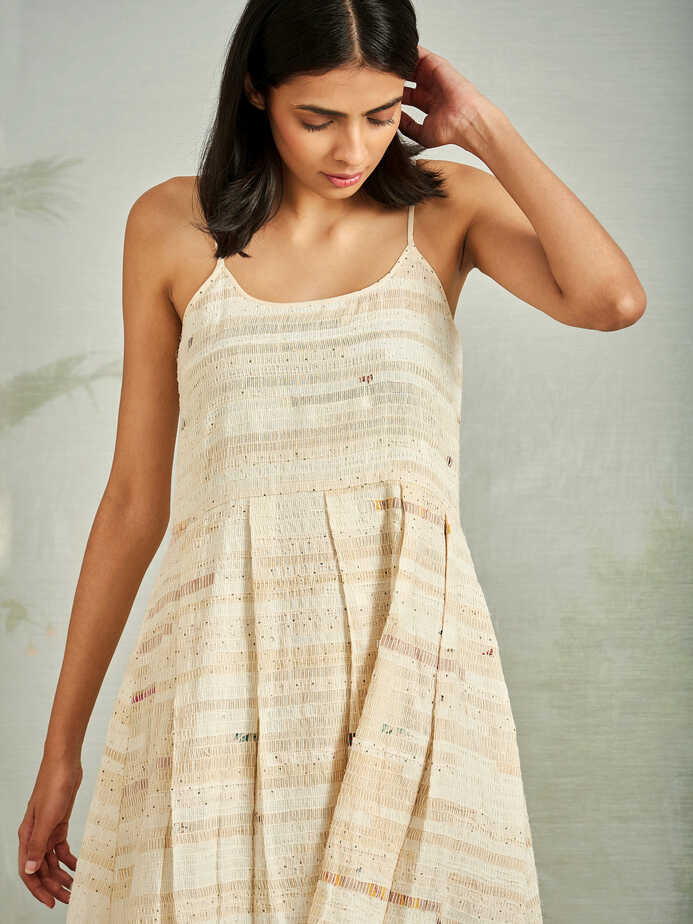
Buna’s studio, a short walk away from Chattarpur metro station, is a serene setting in an otherwise rugged South Delhi neighbourhood. Founder and chief designer Pallavi Shantam’s room is well lit, putting out her recent summer collection into prominence.
A window overlooking the building across the street is no exquisite view, however, the light outside is a fine reminder of the onset of monsoon.
Shantam’s spring-summer collection features a textile made from scrap fabric collected ever since the brand came into being a couple of years back. Strips of fabric used as weft on a cotton thread skeleton made out of kora warp is in fact woven on a loom. This fine textile is a great example of the brand’s take on textile and craft.
“I have been collecting these pieces for a while and I am attached to them in a funny way and do not want to throw them. These pieces are pattern off-cuts. I had other ideas for these waste textiles I was collecting, like making small pouches but it is not exactly what people desire,” shares Shantam who then came up with an idea of developing a textile that was going to be in sync with the brand’s main product range.
After trying various techniques of stitching the fabrics together, she collaborated with a firm in Noida that helped her create what the textile is now. “This is hundred per cent handmade,” affirms Shantam.
As all of the textile that Buna uses for their collection is hand-spun and handmade, often using Jaamdani and block printing techniques, the idea of re-weaving these carefully cut fabric waste to fit the pattern of another loom makes this textile an ultimate product. It takes about a day’s time for a karigar to weave a meter of the same. What we find exciting is the unplanned placement of strips that previously had hand-block printing done on them or a little flower or cloud motif between layers of solid ivory strips. This translates into a unique pattern in every meter square.
The designer takes it to another level by using her signature blocks to create colourful imprints on these otherwise ruffled textiles. The graphic patterns are secured well with the right support on the edges and stitches on top to keep it in place.
“As for the response, it has been great. Not so much online, it is mostly when people see it in person, they understand and are able to appreciate details in the fabric. The idea was to create art with this, so it is for people who have an eye for it”, tells Shantam.
As every creation looks forward to acceptance from a shopper and a home, Buna’s double weave textile has found love abroad in countries like France and Dubai but not so much in India. “We are yet to launch the collection at Ogaan so there might be some takers here,” says Shantam who thinks the product is such that it has more of an international appeal. “In fact, we can make a few more outfits and the textile will be out of stock. It is essentially a limited-edition product”, adds the designer.
The studio is currently busy working on its summer 2020 collection and Jaamdani weaves remain a highlight for this collection. For Shantam, the idea is to continue working with the same crafts community and build a relationship by giving the required time, and of course, she loves Jaamdani. Soft flower motifs (which are traditionally geometric patterns) feature in this collection on Bengal cotton of various densities. Pieces of them are put on a mood board behind her desk, letting the room breathe with inspiration and help her visualise what’s next for the brand.
She gets the block printing — a craft which can be easily outsourced to karigars in Delhi —from Sanganer, a town in Rajasthan. It is the quality of blocks and colours that craftsmen in Sanganer assure, that has led Shantam to work with them. The craft is their heritage, being masters of it, they do it with utmost discipline. The detail is such that the designer has used about 14 colours in a single outfit.
As a ready to wear label, Buna offers a delightful range of garments that are not to be missed if you are a lover of all things handmade and natural. It’s experimental textile, part of its last collection that is made out of waste, is an added zing to an already youthful brand.
Rival leagues trigger players’ suspensions and a legal battle in Indian golf, for now
Former Delhi CM Kejriwal criticises Centre, Delhi govt over worsening air pollution, alleges AQI manipulation
Delhi Police raids Nangloi unit producing fake engine oil, seizes over Rs 1 crore worth…
Mukesh Sharma reimagines digital components as living matter in his solo exhibition ‘Decoding Digital DNA’
Nine accused were arrested in coordinated raids as police uncovered organised networks supplying mule bank…
Nearly 1.57 lakh PUC challans issued in two months as Delhi steps up GRAP enforcement…